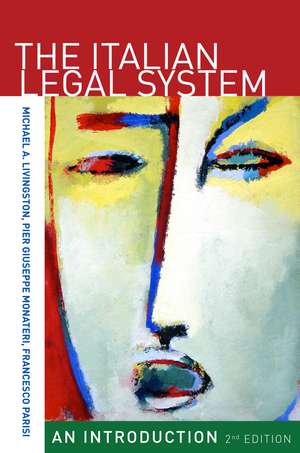The Italian Legal System – An Introduction, Second Edition
Autor Michael A. Livingston, Pier Giuseppe Monateri, Francesco Parisien Limba Engleză Hardback – 20 oct 2015
For fifty years, the first edition of The Italian Legal System has been the gold standard among English-language works on the Italian legal system. The book's original authors, Mauro Cappelletti, John Henry Merryman, and Joseph M. Perillo, provided not only an overview of Italian law, but a definition of the field, together with an important contribution to the general literature on comparative law. The book explains the unique "Italian style" in doctrine, law, and interpretation and includes an extremely well-written introduction to Italian legal history, government, the legal profession, and civil procedure and evidence.
In this fully-updated and revised second edition, authors Michael A. Livingston, Pier Giuseppe Monateri, and Francesco Parisi describe the substantial changes in Italian law and society in the intervening five decades—including the creation and impact of the European Union, as well as important advances in comparative law methodology. The second edition poses timely, relevant questions of whether and to what extent the unique Italian style of law has survived the pressures of European unification, American influence, and the globalization of law and society in the intervening period. The Italian Legal System, Second Edition is an important and stimulating resource for those with specific interest in Italy and those with a more general interest in comparative law and the globalization process.
In this fully-updated and revised second edition, authors Michael A. Livingston, Pier Giuseppe Monateri, and Francesco Parisi describe the substantial changes in Italian law and society in the intervening five decades—including the creation and impact of the European Union, as well as important advances in comparative law methodology. The second edition poses timely, relevant questions of whether and to what extent the unique Italian style of law has survived the pressures of European unification, American influence, and the globalization of law and society in the intervening period. The Italian Legal System, Second Edition is an important and stimulating resource for those with specific interest in Italy and those with a more general interest in comparative law and the globalization process.
Preț: 503.30 lei
Nou
Puncte Express: 755
Preț estimativ în valută:
96.33€ • 100.40$ • 80.19£
96.33€ • 100.40$ • 80.19£
Carte tipărită la comandă
Livrare economică 06-20 ianuarie 25
Preluare comenzi: 021 569.72.76
Specificații
ISBN-13: 9780804774956
ISBN-10: 0804774951
Pagini: 288
Dimensiuni: 152 x 229 x 19 mm
Greutate: 0.52 kg
Editura: MK – Stanford University Press
ISBN-10: 0804774951
Pagini: 288
Dimensiuni: 152 x 229 x 19 mm
Greutate: 0.52 kg
Editura: MK – Stanford University Press
Recenzii
"Three of the world's most learned, humane, and intellectually courageous scholars have joined forces to produce this introduction to one of the world's great legal traditions. This book belongs on the shelf of every serious student of comparative law."—James Whitman, Yale Law School
"This updated, deeply revised edition of Merryman's classic and pioneering work on the Italian legal system exposes the deep transformation of Italian law under the pressures of globalization. It's a welcome addition to a body of literature aimed at showing a Latin civil law experience under siege. An important contribution."—Ugo Mattei, UC Hastings and University of Turin
Notă biografică
Michael A. Livingston is Professor of Law at Rutgers Law School. Pier Giuseppe Monateri is Professor of Law at the University of Turin. Francesco Parisi is Professor of Law at the University of Minnesota.
Cuprins
Contents and Abstracts
1History of Italian Law
chapter abstract
This chapter traces the history of Italian law from the Roman period through the beginning of the Italian Republic (1946). It explains the history of Italian law in relation to the cultural, political, social, and economic histories of Italy.2Italian Government
chapter abstract
This chapter describes the Italian political system, the principal political parties, and the outlines of the judicial system as they existed in the mid- to late 1960s. There is also a brief discussion of the government's role in the Italian economy.3The Law Professionals
chapter abstract
This chapter discusses legal education, the legal profession, and the magistratura, as they existed at the time of publication.4Civil Procedure and Evidence
chapter abstract
This chapter provides an overview of civil procedure, including historical background; constitutional norms; investigation and discovery; appeals and judgments; and trends in procedural scholarship. There are also briefer discussions of the laws of evidence and of criminal and administrative procedures. The differences between Italian and American procedural norms, which flow from the civil¿common law distinction but are augmented by various historical differences, are a major theme of this chapter.5The Italian Style: Doctrine
chapter abstract
This chapter traces the development of a distinct Italian "style," which is characterized by an inclination toward legal positivism; a reluctance to consider nonlegal disciplines, notably philosophy, economics, and the remaining social sciences, in legal scholarship; and a tendency, extreme even by civil law standards, to elevate doctrine over case law. These tendencies result, in turn, from a combination of French and German influences and specifically Italian traits, including the long period in which Italy lacked a central governmental authority and relied on scholars ("doctors") of law to maintain continuity.6The Italian Style: Law
chapter abstract
This chapter continues the themes introduced in Chapter 5, emphasizing characteristic Italian attitudes such as the limited (primarily legislative) sources of law; a sharp division between public and private law; and the centrality of codes (especially the civil code) in the legal firmament. These features were changing by the late 1960s as a result of several developments, including the increased economic role of the state, the rise of the Constitutional Court, and the growth in fields that did not fit easily into existing categories.7The Italian Style: Interpretation
chapter abstract
This chapter¿arguably the grandest in the book¿traces the Italian style as it affects legal interpretation. It describes the difference between the "folklore" of interpretation, under which the judge is merely the mouthpiece of the statute, and the actual practice, in which the judge's values, beliefs, and attitudes inevitably affect the outcome of cases. The core of the chapter is devoted to the work of three scholars¿Emilio Betti, Tullio Ascarelli, and Piero Calamandrei¿who attempted to resolve this problem, the last with an ambitious theory regarding the need to update interpretation to meet the demands of a democratic society. The chapter concludes with a brief section that summarizes the themes of the book as a whole.














